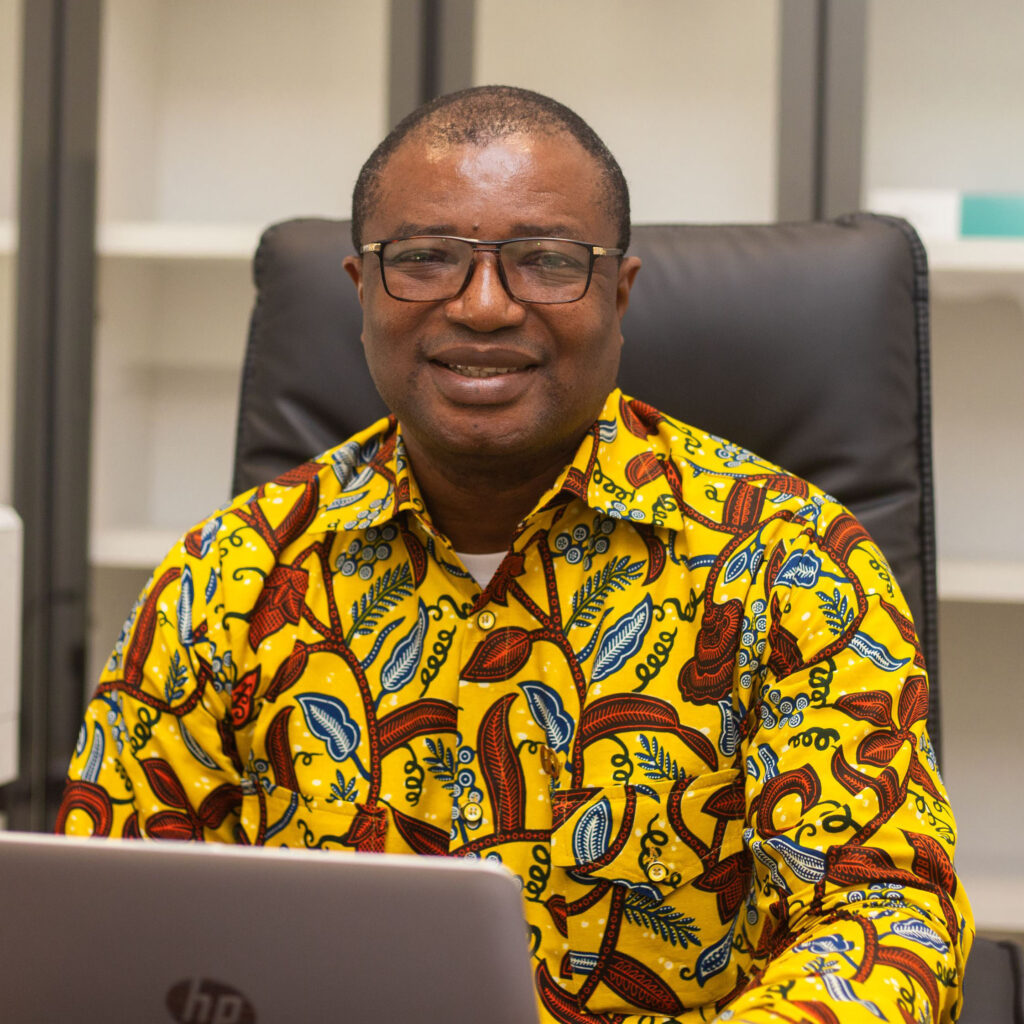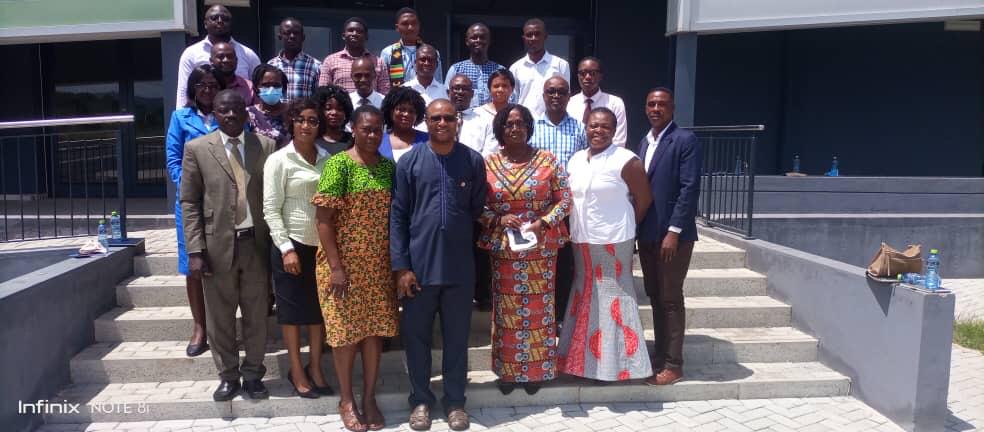The Vice-Chancellor of the University of Environment and Sustainable Development, (UESD), Professor Eric Nyarko-Sampson has unveiled his short and long term vision to the leadership of various unionised groups on campus, in an interactive session at the University’s Multipurpose Auditorium.
The participants were made up of representatives of Senior Members and Senior and Junior staff to the University Council. The rest were local Union Leaders of Teachers and Educational Workers Union (TEWU), University Teachers Association of Ghana (UTAG), Ghana Association of University Administrators (GAUA) and the Students Representative Council (SRC).
The presentation which was in two parts consisted of the Vice-Chancellor’s ten (10) point general vision for the University to be implemented on a short, medium and long term basis; and his short term vision, premised on six pillars, from 1st June, 2020 to July 2022.
The meeting was to enable Prof. Nyarko-Sampson, the first Vice-Chancellor of the University, to share his vision with the union leaders and to figure out how they can contribute to achieving it.
The meeting was coordinated by the Registrar, Mrs Mary Abena Agyepong.
Prof. Nyarko-Sampson likened the UESD community to a ship and its cabin crew, with each person performing a specialized function to contribute to a successful sail, as envisioned by the captain. The ship, he said, can sail well, stop on the way, get stuck, sink or be successful depending on the commitment of the crew members to ensure a successful sail. He likened the Union Leaders and Council representatives to crew members on a ship, who he said exercise some level of control over the personnel they lead for the general success of their institutions.
Hence, the rationale for engaging them is to share his vision to enable them to understand, to better guide the people they lead in working to achieve the mandate of the University as one well versed in issues of the Environment and Agro business.

VC’s GENERAL VISION
The general vision was made up of Programmes (academic and non-academic), Technology, Finance, Linkages and Collaboration, Collaborative Research, University Faculty and Staff, Students, Institution of Faculty and Staff Award, Internationalisation and Security.
On programmes Prof. Nyarko Sampson said, the University’s Vision is to develop programmes that are competitive, demand-driven and market-oriented to meet individuals and the needs of organisations. Also, seminars, lectures, symposia, workshops and conferences would be encouraged in the University to enhance the skills of staff and students.
The Vice-Chancellor indicated that technology would be vigorously pursued to make teaching and learning technologically driven.
On finance, he said, fundraising activities would be vigorously pursued and that he would ensure the prudent use of the University’s financial resources. He further indicated that Departments, Sections and Units would be identified to generate income for the University, citing the University’s ultra-modern laboratory which can be used to generate funds through research.
Explaining the concept of linkages and collaborations with other Universities, Prof. Nyarko-Sampson said, Lecturers could use links to draw synergies and share best practices. The collaborations could be to discuss and make input into new programmes developed, and those to be reviewed. He would want faculty members to partner with colleagues globally to undertake their researches and urged faculty to bring the institution to industry and vice versa.
As his fifth vision, Prof. Nyarko–Sampson encouraged collaborative research both internally and externally. Such collaborations he believes would lead to the development of infrastructure for a first-class research environment and improve the University’s institutional and research profile.
The sixth vision deals with developing Faculty and staff. Here, the Vice-Chancellor wants a workable relationship among members of staff, bringing on board their expertise to impact their activities, which is the greatest resource of the University.
He also expects members of staff to maintain cordial relationships with the students. He believes, through such healthy relationships, the students would recommend other prospective students to study at the University.
Prof. Nyarko-Sampson’s 7th vision for the University centres on students. He said students need the motivation to challenge themselves to become achievers. He envisions the creation of what he called a ‘think tank’ building where students can sit, reflect, innovate and set short and long-term plans and work towards achieving their goals.
He commended the role of the School of Sustainable Development in establishing relationships with institutions like the CSIR and Ghana Water Company Ltd., and how the institutions could fuse in courses into the curriculum of the school, such that students who graduate could be employed at the institutions.
Prof. Nyarko-Sampson wants Lecturers and members of staff to treat students as stakeholders. He also wants the students to be guided by the UESD Honour Code, where freshers are required to recite, in addition to their Matriculation Oath. (This was done during the maiden Matriculation of the University in February, 2021.) The Honour Code is an undertaking of the students, individually and collectively.
The Vice-Chancellor reiterated his dream to produce students of H.O.P.E. That is, churning out graduates who would be Honest in their dealings with society, seizing and creating Opportunities, Persevering in life and be Enterprising.
The institution of annual faculty and staff awards is Prof. Nyarko-Sampson’s eighth vision for the University. It seeks to institute annual awards to honour staff members who have worked extraordinarily hard, to motivate them to do better and also encourage others to do the same.
The 9th vision is Internationalization, where the Vice-Chancellor envisages the University to become an academic citadel for hosting international conferences, admitting international students and signing MOUs for funding projects.
Security is his tenth vision for the University, which he describes as paramount. The entry and exit points of the institution would be highly monitored by the deployment of Security cameras to ensure miscreants do not have a field day on campus.
There are also plans to introduce scannable Identification cards for verification by the security personnel on campus.
VC’s SHORT TERM VISION
In his second presentation which touched on his short-term vision, Prof. Nyarko-Sampson said, he intends to execute this vision premised on six pillars, from 1st June 2020 to 31st July 2022. These are Leadership, Academic Programmes, Teaching and Learning, Information Technology Infrastructure, Resource Mobilisation & Allocation, and Community Engagement.
1. On Leadership, Prof. Nyarko-Sampson said, the University provides a mix of transactional and transformational leadership styles. His first point of focus is on the Leadership of the University and hopes to equip the leaders with the requisite tools to work with, motivate and listen to them and ensure that they do the right thing.
2. Academic Programmes. It is the Vice-Chancellor’s vision to keep the mandate of the University running into becoming a first-class University with,’ student-centred academic programmes, career-focused education and training developed in consultation with relevant professional bodies and industry and leadership with local relevant institutions and foreign institutions’, he posited.
3. Under Teaching and Learning, Prof. Nyarko-Sampson commended members of staff for their selfless contribution to the running of the University since they assumed duty in the latter part of December and in January.
4. Information Technology Infrastructure: In the Vice-Chancellor’s words,’ ‘we will be deliberate about Information Technology. The requisite ICT facilities would be provided to enhance the work of the University.
5. On Resource Mobilisation & Allocation, Prof. Nyarko-Sampson among other things raised these points, adopting an entrepreneurial approach to running the activities of the University, forming public-private partnerships in the provision of facilities and equipment needed to achieve the mandate of the University.
6. Community Engagement: The Community Engagement Projects and Innovation Unit (CEPIU) has been created under the Vice-Chancellor’s office. It is aimed at helping to develop the community in which the University finds itself. Shortly, it would be transformed into the Centre for Community Engagement. Prof. Nyarko-Sampson explained that the office, among other things, focuses on helping to develop communities around the University by engaging them, exploring alternative livelihood for the people, engaging in collaborative research on the major farming crops of the University, workshops, symposiums, community development and organising career fairs with other institutions.
At the end of his presentation, Prof. Nyarko-Sampson was hopeful that the leaders of the various Unionised groups would help him to achieve his vision.
The Union Leaders in turn commended Prof. Nyarko-Sampson for his visionary leadership for the University and pledged their support for him in line with his vision for the University.
In her closing remarks, the Registrar, Mrs Mary Abena Agyepong said, as leaders, it is good to understand the vision of the Vice-Chancellor and the University as a whole to be in a better position to explain to their colleagues, to buy into it. She said, ‘where there is no vision there is no hope and an organisation that has no vision loses its direction.’ She told the participants that, ‘we all have a great potential to help run the University. Adding that ‘great leaders create more leaders, not followers and the more one’s mind is fed with positive thoughts, the more one can attract great things into his/her life. Mrs Agyepong thanked Prof. Nyarko-Sampson for his exemplary leadership and pledged the support of staff to achieve his vision as Vice-Chancellor and the University as a whole.

